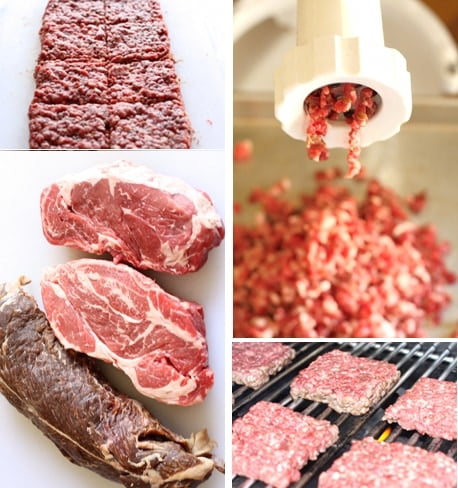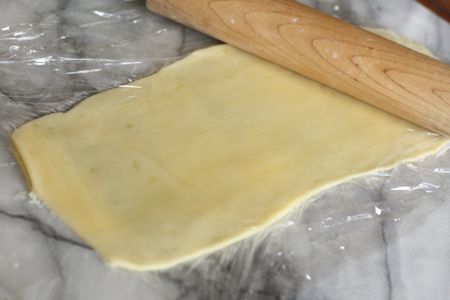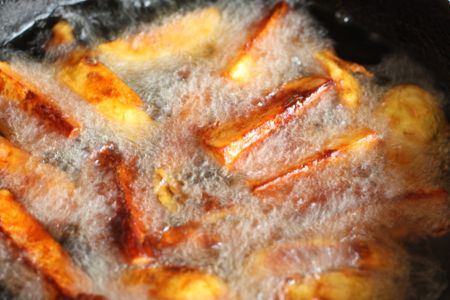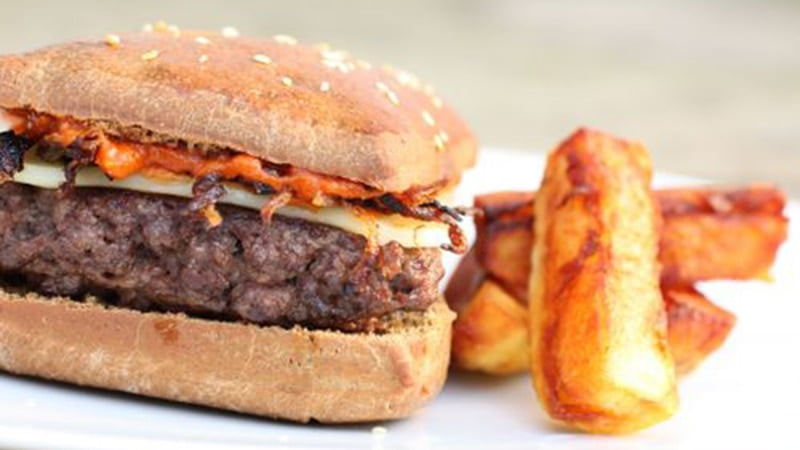Wait, wait, don’t go…you’re at the right place. Really, you are. I know…I’m giving you a burger. But it’s a special burger. Let me tell you why.
First, this is no fast food burger. It’s about as slow as it gets. The hangar steak for the burger was marinated for 12 hours, then dry-aged for 3 days. The shittake buns needed to rise (twice) before being baked into soft pillows. The tomatoes were slowly roasted in a low oven to concentrate their flavor, then reduced to a paste on top of the stove. The onions were slowly caramelized, then dried until crisp in a slow oven. Even the cheese was transformed.
But the whole point of this burger is flavor. The kind of synergistic deliciousness that comes from the layering of glutamate-rich foods that produce the taste of umami.
Umami–the fifth taste–is a chemical reaction that takes place on our taste receptors to produce a pleasant savory taste. As far back as 1825, Brillat-Savarin described the taste of meat as “toothsome” which is similar to the Japanese interpretation of “deliciousness”. Brillat-Savarin also sagely foretold that the “future of gastronomy belongs to chemistry”. As it turns out, it was chemistry that led to our understanding of glutamates, a type of amino acid, and the discovery of the synergy that occurs when foods containing glutamates are combined, the resulting taste is increased and magnified exponentially.
Recently, scientists have uncovered the way that glutamates activates the nerves on our tongues. Referred to as the “Venus flytrap” mechanism, “Glutamate lands on your tongue and nestles into a glutamate-shaped depression on an umami receptor. Upon contact, the receptor–an enormous, folded protein–changes shape and grasps the glutamate. That shape change also activates the neuron that tells your brain you are tasting umami. Inosinate(compound found in meat) and guanylate(compound found in mushrooms) can bind to a seperate part of the umami receptor. Once bound, they tighten the receptors grip on glutamate, increasing its ability to taste up to 15-fold before the receptor relaxes its grip.”
To understand this principle, we have only to examine the intuitive use of umami in world cuisine and how it has led to the foods that we crave. In Italy there is the popular trio of bread, tomatoes and cheese that takes on many forms. In the US, we have the burger and fries–an umami symphony of beef, bread, cheese, tomato, and potato. Mexico has its tacos and wide use of cornmeal and black beans. England loves its fish & chips and Australia knows the secret of Vegemite. Every culture has its versions of charcuterie and fermented beverages. But it is perhaps Asia that has the most extensive and refined applications of umami with their use of fermented soy products, seaweed, cured fish, and mushrooms–all sources of highly-concentrated glutamates.
Interestingly, we have glutamate receptors in our stomachs as well as our mouths. When the receptors in the stomach are stimulated, they send a message to the brain, which then sends an order back to the stomach to start digesting. Latest studies show that glutamates may play an important role in our digestion of protein. Wouldn’t it be nice if, for once, something that tastes good turned out to be not only good for us, but essential to our health?
……………………………………………………………..
Umami Burger Recipe
Recipe in File PDF https://www.playingwithfireandwater.com/wp-content/uploads/2022/11/umami-burgers.pdf
The beef:
Beef is a glutamate goldmine, particularly when cured or aged. To that end, hangar steak was marinated in soy, fish sauce and dashi, then dry-aged and combined with fresh chuck eye steak.
Dashi–a simple broth of kombu and bonito–is loaded with umami. It contains 3700mg of glutamates per 100g.

The bread:
Breads are a good source of glutamates because of fermentation, a process that unbinds protein molecules and allows the release of bound-up glutamate.
Dried shittakes (used here) contain 1060mg of glutamate(guanylate) per 100g as opposed to fresh, which contain 71mg/100g. The dough also contains soy sauce and fermented black beans to produce an incredibly savory and fragrant bread with a soft texture attributed to the addition of milk and eggs.
The tomato:
Ripe tomatoes have 10 times more glutamates than unripe. Roasting tomatoes also concentrates the glutamates and deepens the flavor. Kecap manis (sweetened soy sauce) is added in the reduction stage to increase the umami and mimic the ripening.
Most of the umami in tomatoes is concentrated in the seeds and inner membranes, so be sure to leave them in when cooking and strain out later.

The cheese:
Parmesan has the highest concentration of glutamates among cheese with 1680mg per 100g. As a general rule: the older and drier the cheese, the more umami. Because Parmesan is very dry, it doesn’t make a good “melty” cheese–a requirement for a good burger–yet there had to be a way to make it work. Digging through online science journals, I hit on the secret to making processed cheese. It’s as simple as using sodium citrate as an emulsifying salt. With just two ingredients–sake (for umami) and sodium citrate– it became possible to turn dry and crumbly Parmesan into a soft and supple sheet.

The potatoes:
Pre-cooking potatoes with dry heat is the best way to achieve a crackling-crisp crust with soft, fluffy innards and the microwave is much quicker than an oven.
Scoff if you want, but I make my fries at home in the microwave. On second thought, don’t scoff until you try it. The process is so simple and the results so satisfying that you’ll wonder why you never did it this way before

Related Articles to Foodplay Recipes
- Crispy Asparagus
- Methylcellulose Primer
- Honeycomb Candy
- In Watermelon Sugar
- Flowering Teas – Recipe
- The Easiest Recipe Microwave Chocolate Cake
- The Three Friends Of Winter
- Parrano Avocado Pineapple Recipe
- Rhubarb And Fennel Tempura Recipe

I am sure you love food. Otherwise, you won’t be here. As a full-time and a part-time chef at a local restaurant, I know my way around food. Ever since I was a young girl, I enjoyed helping my mom in the kitchen.
We would often experiment with the spices, ingredients, and flavors and create great meals for my brothers and dad. Since cocking was my first passion, I decided to go in that direction. I finished culinary school, got my first job, and started developing my skills.
Later when kids came, I had all the liberty in the kitchen to combine some of the unique flavors. A lot of them were a success, but now and there I would make a couple of mistakes.
